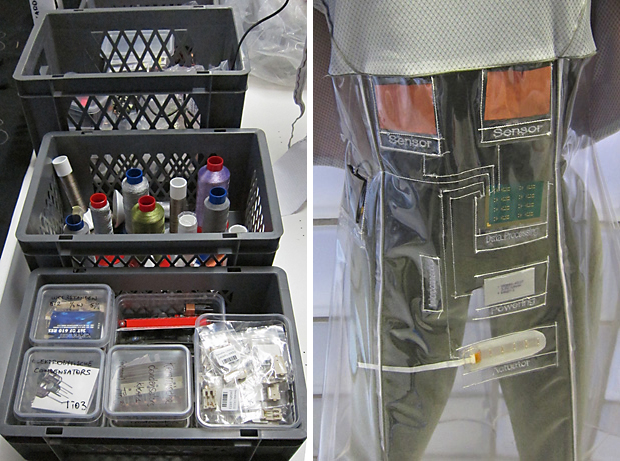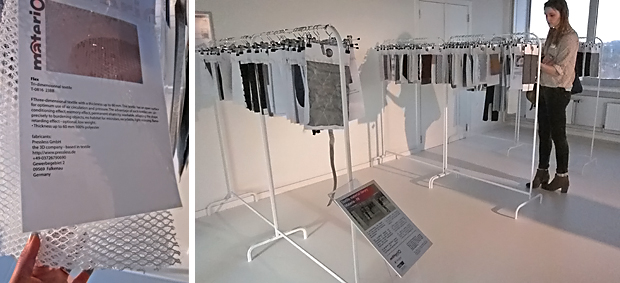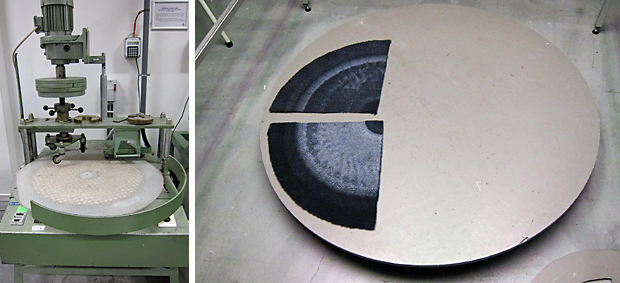Belgium has had a strong textile industry and for the last 20 years the government has been proactive in supporting the industry by funding exciting research. However, they have identified a gap between innovative textile research and the commercial exploitation of that research. Patricia, Debbie and I went to the NeoTextileShop conference in Ghent, Belgium to learn more about how this gap is being addressed.
As I see it there are two different waves in textile innovation:
First wave: New tools computerising the making process: digital print, digital embroidery, laser cutting, computerised looms and 3-D printing.
The benefits of these new tools is that they enable sampling, short runs and have the potential to increase the speed to market and facilitate a move away from mass-market production. Less space is required for manufacture.
Second wave: New yarns and fabrics, and smart textiles, including nano fabrics, fabrics/clothing that include electronics, functional fabrics designed to support specific tasks etc.
The benefits include improving specific needs eg better protection for fire-fighters. Smart textiles have the potential to change the way we live, how we use and see textiles – rather like mobile phones have created a new user need; in the 80s could we have predicted how we use mobile phones now?
The first wave is starting to make an impact on the textile industry, the second wave is still in its infancy, still exploring user needs and how we will be using smart textiles in the future.
The Belgium approach to addressing the innovation gap has been to set up TIO3, the Textile Open Innovation Centre, in Ronse with 51% private and 49% public funding. The NeoTextileShop conference was held at TIO3 and we were lucky to get a tour by the Director, Pierre Van Trimpont. The aim of TIO3 is to inspire with new materials, new processes and new technologies in the field of textiles, including exhibitions and a materials library; create a platform to experiment with their Fab(ric) Lab; and provide business support, including textile industry knowledge and networks, for start-up textile businesses. Business support advice is open to all EU citizens, the first two meetings are free; any further meetings are charged.
The speakers at the NeoTextileShop conference were either supporting textile innovation or introducing their research. Centexbel, the Belgian Textile Research Centre, carries out a huge range of textile research projects with industry partners. Their projects include developing smart textiles, sustainability, improving properties of textiles, and meeting real-world needs with textiles. The projects that caught my imagination were:
S(p)eedkits working with the Red Cross to re-design emergency response kits (tents, blankets, food, water) used in disaster relief through smart packaging and new technological applications using light, strong, durable textiles.
Smart textiles and lighting projects: SmartPro, Poleot – printing light emitting devices on textiles, Place-IT – integration of lighting into light, flexible textiles either for healthcare, interior lighting or safety clothing.
All4Rest improving the quality of sleep by looking at physical and thermal comfort using biomaterials and research of new ones, reactive sleep systems that monitor sleep quality and use heat-able/cooling textiles to improve comfort.
The next day we visited Ghent University, their Textile Department is part of the Faculty of Engineering and Architecture; it focuses on the science and technology of textiles rather than design, and has accredited textile laboratories that they share with Centexbel. The University does a lot of research, including smart textiles, however they did say that they found it useful to collaborate with design students to make polished prototypes. Excitingly they provide an e-learning course on smart textiles in English.
- information about textile tools and innovation, including sustainability
Exhibitions, symposia, conferences, shows – Stroud International Textiles, the Crafts Council, Victoria and Albert Museum (Power of Making 2011), Wearable Technology trade show in London, yearly in March. Google Alerts could be good way of keeping up to date with a particular topic. - materials library – Mark Miodownik (Institute of Making) argues that new project discussions are entirely different surrounded by materials, rather than limited to post-its on the wall. As far as I know there are no materials libraries in the South West.
Institute of Making (UCL), Material Lab, Rematerialise a sustainable materials library (all London), MateriO (France, Belgium +). - access to new yarns and materials, in small quantities It is no good for experimentation if the smallest quantity is a pallet.
The Handweavers Studio (I use a lot of their yarns) and individual manufacturers. - access to new tools, workshops and training.
Most universities with textile design courses, including Somerset College, have the new tools. Z Twist has given us mid-career artists’ access, and there are bureau facilities available. However access to industrial looms is not as easy, The Weave Shed has a list of commission weavers, but a lot of mills are small and specialist, there is the cost implication of minimum lengths and often there is a waiting list. Weavers may need to go abroad for training in industrial weaving. - opportunities for collaboration (and networking) Collaboration with industry, collaboration between different disciplines, and especially collaboration between the arts and the sciences, essential for the development of smart textiles.
Residencies programmes including Z Twist, Crafts Council (The Watershed 2013, Craft Rally). But, I think collaboration needs to be introduced earlier, at university. Working well with other people is a key ingredient to success in your working life, but English universities are very focused on individual achievement. Taking a different approach is the Institute of Making a research club for interdisciplinary making at UCL, the Building Virtual Worlds class at Carnegie Mellon University which takes students from different backgrounds and puts them together to build a virtual world – graduates who took this class have gone on to work for Walt Disney Imagineering etc - textile/craft-specific marketing and business advice, and knowledge
Crafts Council (Hothouse support for emerging makers, Injection business development support for mid-career makers), The Design Trust (on-line and events), a-n The Artists Information Company (on-line, networking and events), Cockpit Arts (London, studio-based). - funding for production and marketing The transition from a successful hand-maker to manufacturing is a big step that may require a large initial investment eg for minimum order sizes. Taking stands at design events is also expensive.
- raising awareness of good design and the importance of local making
Champions for making include: Somerset Art Works, Stroud International Textiles, Devon Guild of Craftsmen, and the Crafts Council. Intuitively, I think the SouthWest may be behind in design thinking in comparison to a London audience or is that just force of numbers? Contemporary craft/design shows include SIT Select, Stroud, and surroundings, in April/May; Contemporary Craft Fair, Bovey Tracey in June; open studio events including Somerset Open Studios in September; and smaller open studios in Bath in May including Bear Flat Artists.





